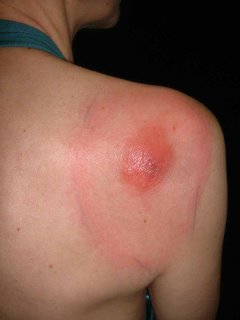The patient lives in rural New Hampshire and gardens a fair bit. She was seen two times at a primary care clinic where a diagnosis of spider bite was made. First she was given Keflex, then amoxicillin.
Diagnosis: I am uncertain. I favor Lyme Disease but this has atypical features. The central nodule is unusual, although the peripheral ring looks like Lyme. I also considered atypical Sweet's Disease and a pyogenic process. Lastly, I thought of eosinophilic cellulitis (Well's Syndrome) which I have never seen.
Plan: Since she feels well, I prescribed Doxycycline 100 mg bid, and ordered a cbc, Lyme titers and a G6PD (if the lesion becomes necrotic may want to try Dapsone. I considered biopsy but was strapped for time and thought Lyme most likely. Now, I am uncertain. Biopsy will be done when she is seen in follow-up unless she is significantly better.
Your thoughts will be welcome.


Addendum:
Path Report:
DIAGNOSIS: Skin - (A) Right Shoulder-Periphery-Ring Surrounding Nodule:
Tight, mild superficial and deep perivascular lymphocytic infiltrate .
NOTE : These changes are those of a dermal hypersensitivity reaction to an exogenous antigen and, given the clinical presentation, are consistent with erythema chronicum migrans .
DIAGNOSIS: Skin - (B) Right Shoulder-Nodule:
Broad scale crust containing neutrophils , epidermal hyperplasia , marked papillary dermal edema and a superficial and deep perivascular and interstitial mixed inflammatory cell infiltrate composed of lymphocytes , neutrophils , histiocytes and plasma cells with rare eosinophils consistent with arthropod bite reactio n.
NOTE : These changes may be seen in a tick bite and erythema chronicum migrans . Clinico-pathologic correlation is suggested.
The Lyme Titer is positive.
In my opinion, this is not definitive, but the onus is on me at this time to continue to treat for Lyme.
The patient is on doxycycline and will continue on this at a dose of 100 mg bid for three weeks.
The patient reports that after three days of doxycycline the lesion is smaller. This, too, is not definitive, however, one can not ignore that either.
One Week Follow-up.
The patient feels better. Has mild insomnia.
Although initial lab titer was positive -- the Western Blot was negative indicating an early infection. Our infectious disease consultant expected them to be negative. Early treatment can prevent conversion. Will probably repeat in 2 weeks.
Picture on June 29, 2006

from Brian Maurer
ReplyDeleteInteresting clinical presentation.
I doubt this is Lyme disease for several reasons: (1) the rash developed
dramatically over five days; in my experience the rash of Lyme is usually
more insidious, (2) the central wheal looks rather large for Lyme; most of
the ones I have seen have been considerably smaller and usually fade by the
time the marginal ring develops, (3) the initial lesion was painful; again,
in my experience the rash of Lyme is usually asymptomatic, and (4) two
courses of antibiotics have not dampened down the inflammation as yet; if
this were an infectious process, there should have been some evidence of
clinical improvement. (Unless you're dealing with a MRSA, in which case the
lesion would be painful (rubor, tumor, calor, dolor) and some constitutional
symptoms should be present (fever, malaise).)
If this is Lyme, the antibody screen and confirmatory Western blot will be
positive--no need to biopsy.
A spider bite or some type of inflammatory reaction is a good bet. If
central necrosis develops, I would wager the former. Did she take some sort
of antihistamine at some point? If not, I would consider adding one to her
regimen, e.g. Zyrtec, Clarinex.
from Doug Johnson
ReplyDeleteLooks like insect bite hypersensitivity. She could use some clobetasol
or prednisone or at least some antihistamine. Looks really itchy. Is it?
The picture and course of the disease is suggestive of insect bite hyersensitivity reaction rather than lyme ds.Treatment will be accordingly
ReplyDeletekhalifa sharquie
my impression is that this is an insect bite vs infection with a pyogenic. The last one
ReplyDeleteis less likely because: the pain subsided quickly,the presence of the ring and the nodule hasn't resolved with abx or abcessed in case of abx resisitance.
An i.d. specialist sent us this before the final Lyme Titers came back:
ReplyDeleteYour patient's lesions are actually classical for Lyme Disease. In fact many of the ECMs are target lesions with darker centers. I was under the (?false) impression that serology would probably be negative at this point, and that if you treated (which of course you should), it may blunt the rise in titres. What were the actual results of the titres? L.E. M.D.
His impression turned out not to be false -- the patient may have had previous exposure to tick bites -- she lives in a rural area and brought me in ticks she has been collecting for 6 or 7 years!! DJE